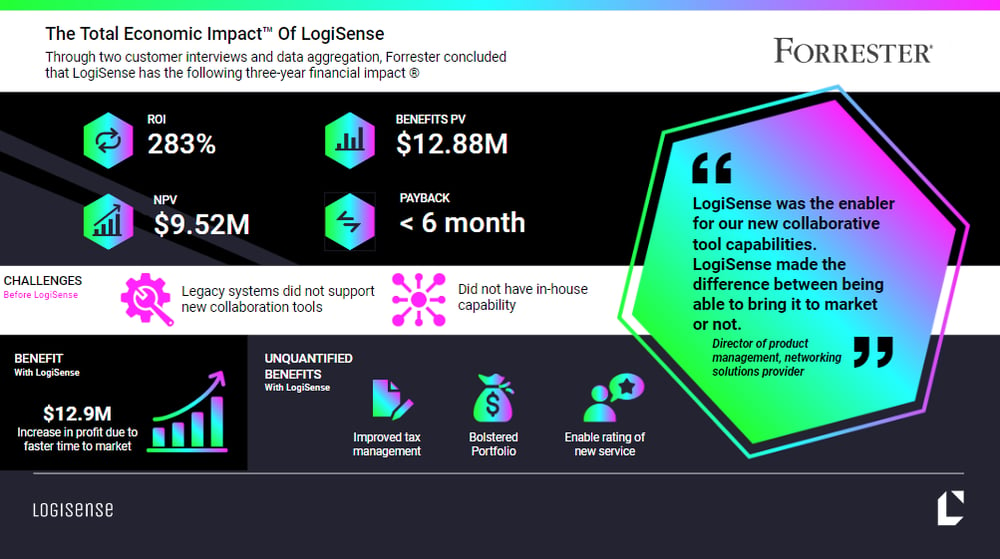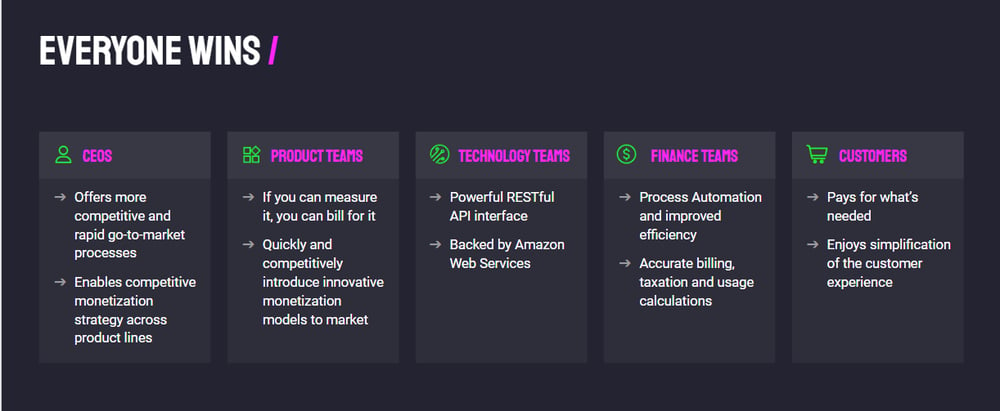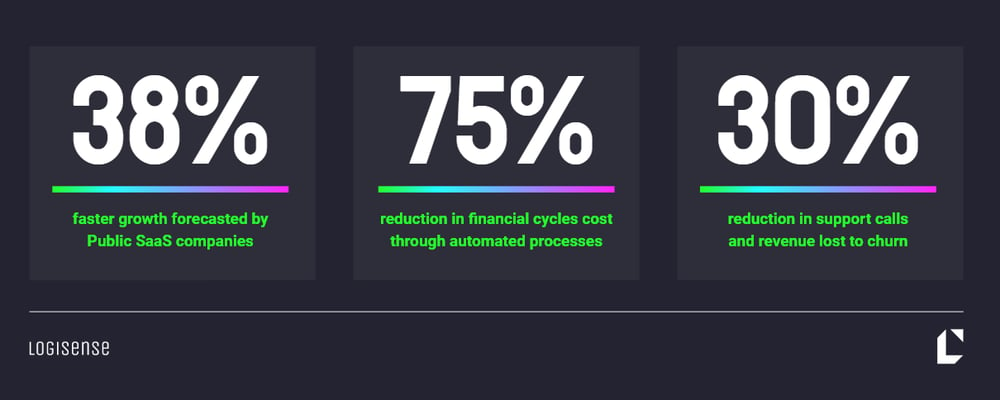What if flexible billing could provide you with similar statistics to the graphic below?
These are the types of numbers that our clients experience after implementing a flexible billing solution. If the potential to get these numbers isn’t reason enough to take the plunge, you should also realize your customers are wanting flexible billing as well. There are a ton of reasons to make the switch so let’s go over the major ones.
Customers pay for only what they use
Customers want to feel that they're getting value for the products and services they pay for. What is more fair than only paying for what they use? Creating a flexible pricing model enables your customers to set a budget on the amount of monthly usage for your product or services. You can also allow your customers to have draw downs or top-ups once they reach their usage cap which allows you to maximize revenue and give your customers control.
In some cases, a pure subscription model can actually cost you money. When you charge a flat rate for a feature that your customers are using more than expected, your costs will rise but revenue will stay flat. This is not a scalable, or profitable, situation to be in.
After monitoring usage data, we have had clients find out that they were severely undercharging larger customers. They were shocked to say the least.
Launch new offerings and services faster
You will most likely launch new product lines that have completely new billing use cases than your current product lines. Alternatively, you may not have a billing model confirmed yet and need the flexibility to pivot between models to get feedback from users (one-time charges, subscription billing, usage-based billing or some kind of hybrid-based billing).
Capture new revenue streams
The process of capturing revenue can be time-consuming and difficult, leading to compliance errors and revenue leakage. Your business needs to capture new revenue streams in order to stay competitive and grow revenue. A new revenue stream may require you to tweak your current billing management platform and architecture. The last thing you want in this situation is to have to rebuild your billing system because it wasn’t built for this new way to generate revenue.
Just as an example, Forrester Research conducted interviews with one of our clients and found that after integrating our billing system, they were able to capture a 283% ROI in less than 6 months which equated to $12.9m benefit. We don’t mean to brag but that is pretty incredible.

Flexible security
Your customers want to know that their data is protected and that a strong information security policy is in place to protect them. Using flexible billing can improve security by reducing the risk of data breaches.
On-premises billing solutions give businesses more control over their data, but they are also more prone to system breaches. Going with a cloud-based solution that is hosted on a platform like Amazon Web Services (AWS) automatically provides a layer of security that you don’t need to manage. With AWS, its SSAE16 and ISO/IEC 27001 compliant offering, provides extensive protection of data and safeguards against service interruptions.
With the large amount of people that need access to billing, both internal stakeholders and external customers, security is top priority. A flexible solution should allow for users to be given strict credentials, as well as roles or role groups to ensure only the critical users have permission to read, update, or delete data within your billing system.
Real-time reporting
Flexible billing based around usage data unleashes real-time reporting for both you and your customers.
Your customers want to have clear insights into how much data they have used, what is remaining, and if they have gone over the usage limits for the month. For example, you could enable the ability for you customer to specify usage threshold limits for notifications. Some may want to be notified at 50% while others at 80% or above. This ties back into the other aspects of flexibility where you can allow them to upgrade their plan or top-up the amount of data that can be used for the month.
But what is equally important is that billing based on data becomes a huge benefit to your company as well since you now have real-time reporting that can measure:
- Customer engagement and success
- Key metrics and KPIs
- Which features are being used the most
This allows you to tweak your offering to include the most used features, or add additional billing models like draw downs or top up. This will give you clear insights and allow you to make informed decisions about your business.
Operational efficiency
There is more to flexible billing than just the solution you implement. You will gain a huge efficiency burst in every aspect of your business when the right architecture is there to support it.

Just on operational overhead alone, you will become more efficient by:
- Cutting hardware and software costs since your billing solution is managed in the cloud.
- Easily scaling up or down based on usage data without incurring a lot of costs.
- Reducing expenses associated with billing and collections.
Secondly, you will be able to save endless hours of manual work by using modern automation features. We will get into this topic a bit more below but things like webhooks and APIs have introduced a better way to send data which means your billing system can use those to automatically:
- Create and send invoices to your customers.
- Send important notifications and messages about your customer’s subscription or data.
- Email important promotions or reminders.
- Send data to and from other back-office systems
Time savings and automations
Automate the processes that your legacy billing system has you doing manually. For example, you can create an invoice template where your billing system will automatically populate it with what is owed by the customer, email the customer the invoice, and send a text message to remind them they have an invoice that is due. This is the kind of flexibility that will save your team time and money and is just one of many examples of how you can set up your billing system.
Probably one of the biggest automation wins for your team would be from collections and dunning. There no longer needs to be any manual process to accounts that are overdue. Dunning and payment terms are represented by a list of rules that will execute various actions on an account so as to enforce a late invoice payment policy.
As an example, payment terms may be defined to send emails, add late fees to accounts or cancel accounts altogether.
Actions can be specified on a default dunning rule with payment terms to take specific actions: e.g. sending a late payment email once 10 days past the invoice date has been reached.
Automations also tie in well into efficiency and real-time reporting since you can use Webhooks, SMS, or email to send out notifications to any customer or third party service. You can take automation to the next level by:
System Events - When events are triggered (a payment, usage, contact information), your billing system can use automations that you have configured to do the work you normally would do manually:
- Subscriptions and usage, invoice presentment, delivery and dunning.
- Customers can enter payment information through a secure form or simply text "pay."
- Create reports for export to your financial system
Customer Experience - Build automations so your customers can pay bills, cancel plans, receive updated account activity, and email them with important messages.
Data Flows - Organize multiple operations in a single transaction. LogiSense’s data flows organize API calls to create, update, or delete connected data.
Manage a large number of transactions
This is maybe the most critical factor that customers are looking for. The ability to scale from a few thousand transactions to millions a day without the need to rebuild their codebase from scratch or staff a team for 24/7 support/maintenance.
Value-added functionality
The flexibility of your billing means you can add value where standard solutions lack. For example, when you are able to develop different invoice templates and sequences for different lines of business, you open up a huge amount of use cases that you are now able to solve. There are a lot more examples, such as:
- Specify billing attributes for subscriptions, such as payment terms and bill-to contacts.
- Specify different payment terms for different product lines.
- Creating different invoices and sequence sets for each line of business.
- Specifying billing attributes at the subscription level.
You will now be able to transform the post-hoc nature of billing into a personalized experience that can be monetized.
These are just a few of the examples where flexible billing can save you time, increase your revenue, and make your customers love working with you.
About the Author
Tim Neil /
As Sr. Director of Marketing at LogiSense, Tim is responsible for corporate brand messaging and digital assets ensuring that future customers understand the immense benefits that LogiSense Billing brings. Tim has over 20 years of Product Management and Marketing experience in the technology industry.

